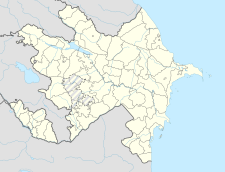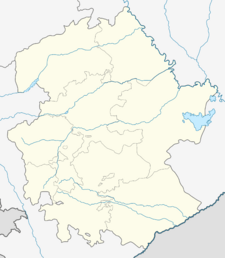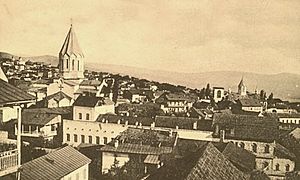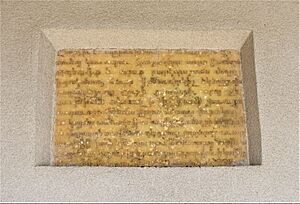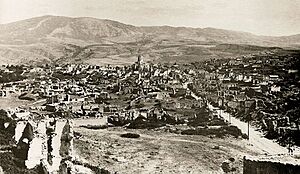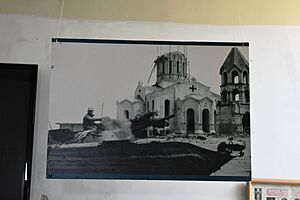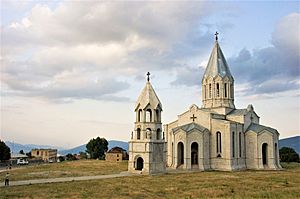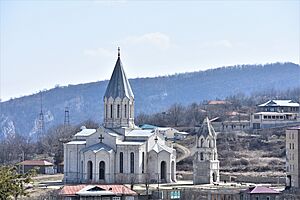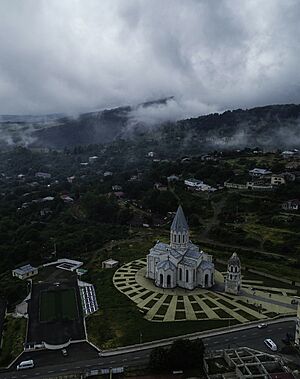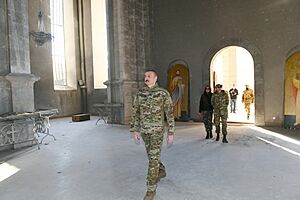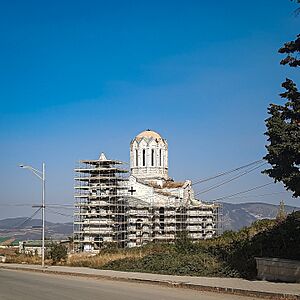Ghazanchetsots Cathedral facts for kids
Quick facts for kids Ghazanchetsots Cathedral |
|
|---|---|
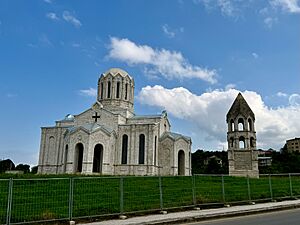
The cathedral in 2024 after a controversial restoration project undertaken by Azerbaijan
|
|
| Religion | |
| Affiliation | Armenian Apostolic Church |
| Rite | Armenian |
| Year consecrated | 20 September 1888 18 June 1998 (reconsecration) |
| Status | Repaired (2024) |
| Location | |
| Location | 19 A. Ghazanchetsots Street, Shusha, Azerbaijan |
| Architecture | |
| Architect(s) | Simon Ter-Hakobian(ts) |
| Architectural style | Armenian |
| Groundbreaking | 1868 |
| Completed | 1887 |
| Specifications | |
| Length | 34.7 metres (114 ft) |
| Width | 23 metres (75 ft) |
| Height (max) | 35 metres (115 ft) |
The Holy Savior Cathedral, often called Ghazanchetsots, is a very important church for the Armenian Apostolic Church. It is located in Shusha, a city in Azerbaijan. This cathedral is the main church for the Diocese of Artsakh.
Standing about 35 meters (115 feet) tall, Ghazanchetsots is one of the biggest Armenian churches in the world. It is a famous landmark in Shusha and the Karabakh region. It is also a key symbol of Armenian culture and faith. The cathedral was listed as a cultural and historical monument by the former Republic of Artsakh.
The church was built between 1868 and 1887 and opened in 1888. It was damaged in March 1920 when many Armenians had to leave the city. The church then slowly fell into disrepair during the Soviet era. During the first Nagorno-Karabakh War, it was used to store weapons. After that war, it was fixed up and reopened in 1998. In the 2020 Nagorno-Karabakh war, the cathedral was damaged again by attacks.
In Azerbaijan, the cathedral is sometimes called "Gazanchy." Some people and officials there have said it is not Armenian. They have called it a "Christian" building or even a "Russian Orthodox" one. A "renovation" of the church from 2021 to 2024 caused concern. This was because the original roof was removed.
Contents
Building the Cathedral
Records show that a smaller church stood on this spot as early as 1722. In the 1800s, Shusha was a large and busy city in the South Caucasus. It was even bigger than Baku or Yerevan, which are now capitals of Azerbaijan and Armenia. Shusha was a major center for Armenian culture. In 1886, the city had a mix of Armenian (57%) and Tatar (now called Azerbaijani; 43%) people. There were almost 27,000 residents.
The oldest part of the current cathedral is its bell tower. It was built in 1858. The Khandamiriants family paid for its construction.
The main church building started being built in 1868 and finished in 1887. Its name, Ghazanchetsots, comes from a village called Ghazanchi in Nakhchivan. The Khandamiriants family came from there. Also, the part of Shusha where the church is located was known as Ghazanchetsots quarter. This was because people from Ghazanchi lived there.
Simon Ter-Hakobian(ts) designed the church. It was officially opened on September 20, 1888. An inscription on the church tells us this. It says the church was built with donations from the people of Shushi. It mentions the rulers and church leaders of that time.
Challenges and Decline
In March 1920, many Armenian people in Shusha had to leave the city. The cathedral was damaged and slowly became run down. When the area came under Soviet control, the church was closed in 1930. In the 1940s, it was even used to store grain. Its dome and some walls were destroyed in the 1950s. People also took stones from the church to build houses. By the 1970s, the cathedral looked like it had been through heavy attacks.
Because people wanted the church fixed, Soviet and Azerbaijani leaders allowed a restoration project to start in the 1980s. This work began in 1981 and continued until 1988. Volodya Babayan was in charge of the repairs. By 1987, only two of the four stone angel statues on the bell tower were left.
The First Karabakh War
In February 1988, the Nagorno-Karabakh conflict began. The Armenian people living in Shusha had to leave the city. Azerbaijan then used the cathedral as a place to store weapons. Some reports say the church was set on fire several times between 1988 and 1991. The stone angel statues on the bell tower were taken down in 1989. The church's large bronze bell was reportedly sold. Later, an Armenian officer found it in a market in Ukraine and bought it back.
Before Armenian forces took Shushi, Azerbaijani forces stored many boxes of missiles inside the cathedral. This was because the church was safe from possible Armenian attacks. Shusha was used to launch rockets at Stepanakert, the largest city in Karabakh. After the city was captured, Armenian volunteers helped remove the weapon boxes from the church. The flag of Armenia was raised on the damaged dome. One visitor noted that the church's "windows were missing, but the inside was in reasonable condition."
On August 23, 1992, Azerbaijani planes attacked the church. Luckily, no one was seriously hurt. Some people believe this attack was meant to harm Armenian culture in Karabakh.
Restoration and New Life
Work to fix the cathedral started soon after Armenian forces took the city. By 1997, it was one of the only buildings being restored in Shushi. Volodya Babayan led the restoration work. Andreas Roubian, an Armenian supporter from New Jersey, gave a lot of money for the repairs. Many other Armenian communities and wealthy people also donated. The cleaning and furnishing of the church finished in May 1998.
The cathedral was officially reopened on June 18, 1998. Archbishop Pargev Martirosyan led the ceremony. The first church service in the restored cathedral happened on July 19. The president of Nagorno-Karabakh and officials from Armenia attended.
Many people saw the church's rebuilding as a way to bring back Armenian culture and spirit. It became a symbol of Shushi's rebirth. One writer said in 2003 that it "towers, immaculate once more, above the ruined town." In 2009, another writer noted that it was "one of the few pristine-looking buildings in the city."
On October 16, 2008, a large group wedding took place in Nagorno-Karabakh. About 700 couples got married that day. 500 of them married at Ghazanchetsots.
On April 14, 2016, two important church leaders, Catholicos Karekin II and Catholicos Aram I, prayed for peace at the cathedral. This happened after fighting between Armenian and Azerbaijani forces.
On April 6, 2017, Serj Tankian, the lead singer of the band System of a Down, sang a Christian prayer in Armenian at the cathedral.
2020 Shelling Incidents
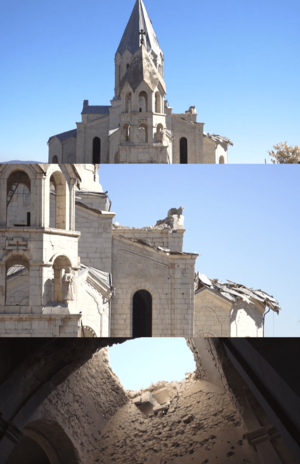
On October 8, 2020, the cathedral was hit twice during the 2020 Nagorno-Karabakh conflict. Part of the roof collapsed. A Russian journalist was badly hurt by the second hit, and two others were also injured. Human Rights Watch (HRW) said that the attacks seemed to be on purpose. This was because the church is a civilian building with cultural meaning. HRW found pieces of the weapons used, which showed that guided rockets were likely used. An investigation found that the church was hit with 300mm rockets.
Even after the church was hit, Armenians continued to visit it. On October 12, a cellist named Sevak Avanesyan played music inside the damaged church. On October 24, a couple got married there. On November 6, 2020, Archbishop Bagrat Galstanyan prayed at the church.
Reactions to the Attacks
- Armenian Reactions: Armenia's Foreign Ministry said it was "another crime" by Azerbaijan. They said it showed Azerbaijan's long-standing policy against Armenians. The Armenian Apostolic Church also spoke out against the attack. They called it a sign of extreme religious intolerance.
- Azerbaijani Reactions: Azerbaijan's Defense Ministry said they were not behind the attack. Their state news agency claimed the missiles came from the Armenian side. Azerbaijan's President Ilham Aliyev said they would investigate. He also said that if it was done by Azerbaijani forces, it was a mistake. He added that the damage was minor and could be fixed quickly.
- International Reactions: The United States Commission on International Religious Freedom (USCIRF) was upset about the damage. They asked for religious sites to be protected. The US Ambassador-at-Large for International Religious Freedom also expressed sadness. Many others, including US and German politicians, condemned the attack. The International Association of Genocide Scholars said the attacks were part of a "cultural genocide." In December 2020, Human Rights Watch asked Azerbaijan to investigate the attacks.
Under Azerbaijani Control
Azerbaijani forces took control of Shusha by November 9, 2020. A peace agreement was then signed. On November 14, a photo appeared online showing graffiti on the cathedral's wall. Armenia's Ministry of Culture said there was already proof of damage to the church. The Armenian Church called it disrespect and strongly condemned it.
After the war, the Azerbaijani government announced they would renovate the cathedral. This project caused a lot of discussion and criticism. Many Armenians said that Azerbaijan was trying to remove the Armenian identity of the church. They believed Azerbaijan was changing its main features. In May 2021, videos showed that the church's pointed dome had been removed. The church was surrounded by scaffolding. Some Azerbaijani officials said they wanted to bring back the church's "original" look. They claimed it did not have the pointed dome until Armenians added it after 1992. However, old photos from over a century ago clearly show the pointed dome.
The United States Commission on International Religious Freedom and International Christian Concern were worried about the renovation. In June 2023, Azerbaijan's Ambassador to the Holy See said the church was "regaining its original appearance." In July 2023, President Aliyev said that Azerbaijan does not touch Armenian historical heritage. He stated that the Armenian church in Shusha was protected. The church's renovation by Azerbaijan was completed in 2024.
Architecture and Design
The cathedral's church has a dome and four rounded sections called apsides. It is about 34.7 meters (114 feet) long and 23 meters (75 feet) wide. Standing 35 meters (115 feet) tall, it is one of the largest Armenian churches. Its dome has a metal pointed roof and is 17 meters (56 feet) tall. The church has three identical entrances on the west, south, and north sides. There are decorative carvings on the entrances and windows. The church's layout is similar to that of Etchmiadzin Cathedral, which is Armenia's mother church. The cathedral is known for combining new building methods with old Armenian architectural styles.
Both the church and the bell tower are built from white limestone. The bell tower stands separately and has three levels. It holds two bells. The larger bell was made in Tula, Russia in 1857. Four statues of angels blowing trumpets stand on top of the first level of the bell tower.
Why the Cathedral is Important
The Ghazanchetsots Cathedral, along with Gandzasar monastery, is a very important symbol for Armenians from Artsakh/Karabakh. It represents their history and identity. Many people mentioned it during the start of the Karabakh movement. It has become a symbol of the city's freedom for Armenians. It is also a popular place for Armenians from Armenia and other countries to visit for religious reasons. In 2016, Catholicos Karekin II called the cathedral a symbol of the Armenian freedom movement of Artsakh. It is also seen as a reminder of the cultural and religious growth in the city during the 1800s and early 1900s.
Many old handwritten books were kept at the cathedral. The oldest one dates back to 1612. A special relic, the Right Arm of Grigoris, was also kept there. Grigoris was the grandson of Gregory the Illuminator, a very important figure in Armenian Christianity.
Official Recognition
The cathedral is on the list of cultural and historical monuments for the former Republic of Artsakh. It is also on the list of cultural and historical monuments for the Republic of Azerbaijan. In 2001, the Shusha State Historical and Architectural Reserve, which includes Ghazanchetsots Cathedral, was added to a special list for UNESCO World Heritage Sites by Azerbaijan. This means it is being considered for official World Heritage status.
See also
 In Spanish: Catedral de Ghazanchetsots para niños
In Spanish: Catedral de Ghazanchetsots para niños


